vaporware: noun software or hardware that has been advertised but is not yet available to buy, either because it is only a concept or because it is still being written or designed.
-Oxford English Dictionary
One of the great resources on Rickenbacker’s webpage is an archive of price lists going back to 1953. But if you spend any time looking at them, you’re going to notice some models you’ve never seen before…because they never actually got made. These, my friends, are vaporware.
You’ll also see guitars listed on these price list YEARS after the last known example was actually made. These are zombie guitars: models that are actually dead, but lurch along (on the price list) as if they were still alive.
What these two groups of guitars have in common was that you couldn’t buy them. Oh, you could place an order with your dealer and put down a deposit, but at some point you’d get your deposit back because it just wasn’t coming.
Now to be fair, F.C. Hall had a habit of keeping things on the price list if he still had one (or more) in the warehouse. Can’t sell it if you don’t list it, right? So MAYBE you could have bought some of these “zombie” guitars….but probably only one or two, and they probably wouldn’t (or couldn’t!) have made more if you asked for it.
Why would you have such things on your price list: guitars you can’t actually buy? Two reasons: optimism and good old fashioned inertia. We’ll see examples of both here.
A quick note: I usually like to include good, high resolution pictures of the guitars we discuss. By definition, that’s going to be difficult here. In some cases, at least one and perhaps a handful of prototypes were produced, but good photos of them are few and far between. In other cases, none were actually ever produced, making providing photos impossible. I’ll do the best I can to describe. Apologies in advance.
1953-1956
Vaporware: 0
Zombie guitars: 0
Modern electric “Spanish Guitars” first appeared on the price list in 1954, with just the Combo 600 and 800 offered. The Combo 400 joined them in 1956. So far, so good!
1957
Vaporware: 1
Zombie guitars: 0
In 1957 two new items were added to the price list: the Combo 850 and 650. The 850 was an evolution of the Combo 800, with the upper cutaways reshaped into an outline instantly recognizable today as the modern 325 and 350. Solidbodied, unlike the 850, it still featured a German carved top and added an additional pickup in the neck position—the first new pickup designed in house since the horseshoe: the toaster. By the end of its short run (last known example is from 1959), the horseshoe pickup in the bridge would be replaced with another toaster.
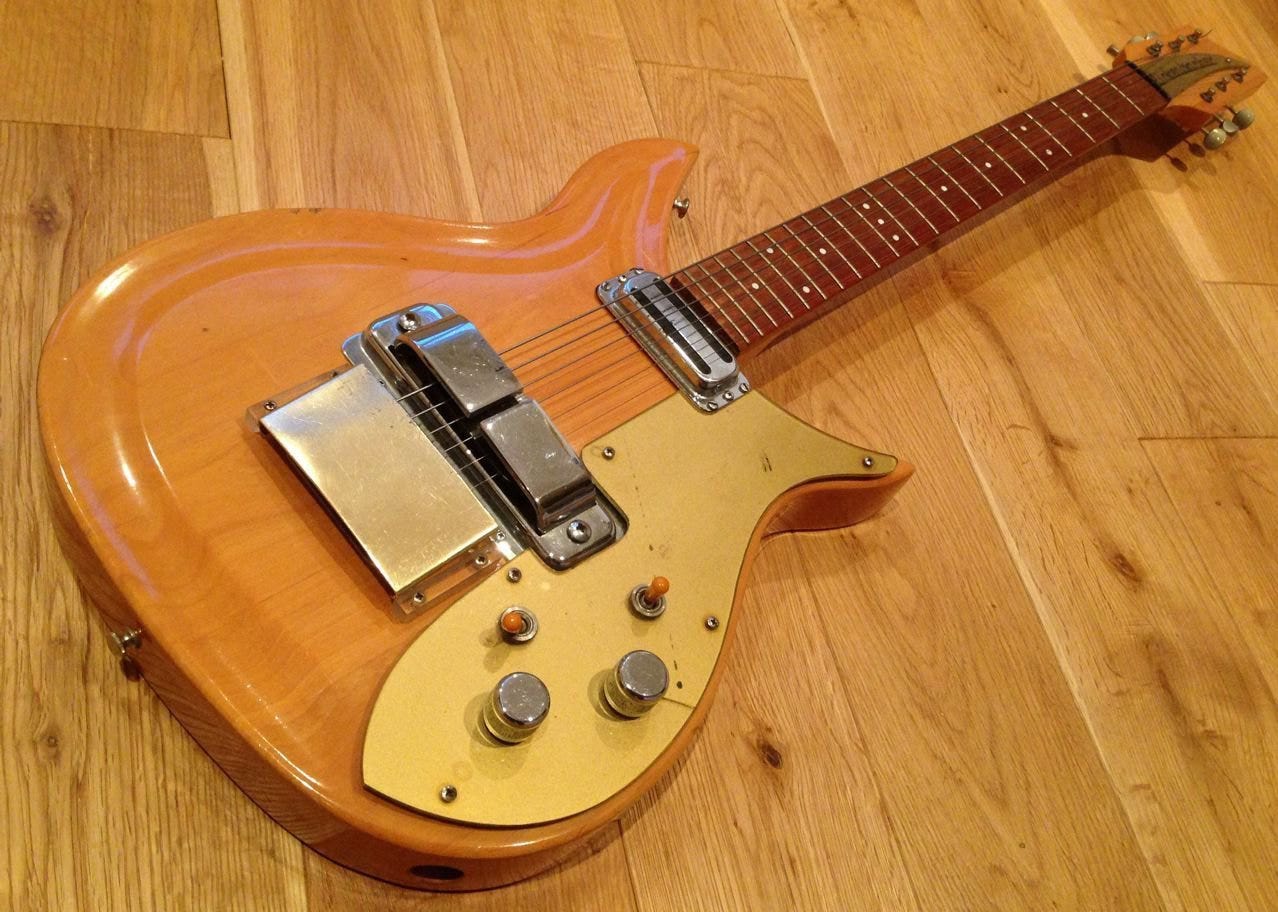
The 650 was the same guitar, but without the neck pickup. In theory. Offered on the price list in both Natural and Turquoise, while a handful of prototypes and trade show models were built it does not appear that the 650 ever actually went into production. Our first example of vaporware!
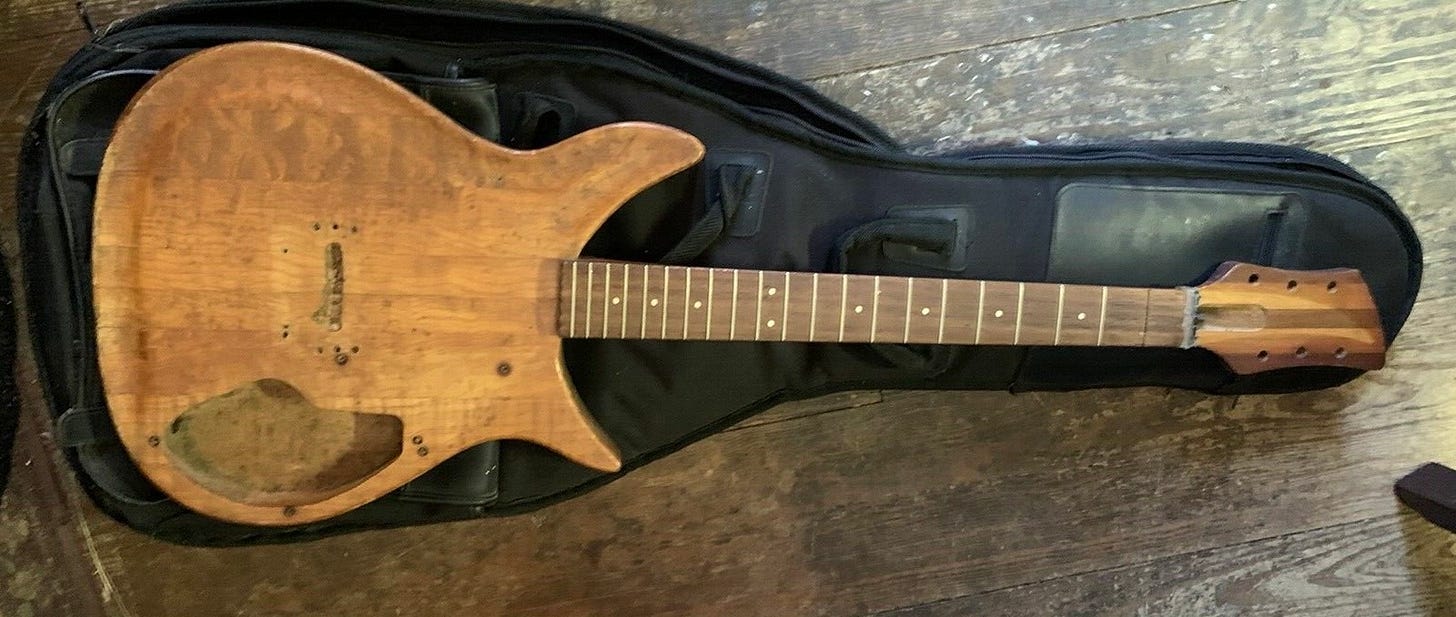
You could argue that one other item from the 1957 price list is technically vaporware—the 4000 bass—but because it would eventually go into production we’ll call it good. That’s the rule we’re going to use going forward: early is ok, as long as production actually occurs within a year or so.
1958
Vaporware: 16
Zombie guitars: 0
The price list exploded in 1958, going from 10 distinct models to 37! And, yup, a BUNCH of them were vaporware—16 to be exact: 15 new ones, and the 650. In fact, those 15 guitars made up a whole LINE of vaporware guitars: the “Capri Series, Thick Body”.
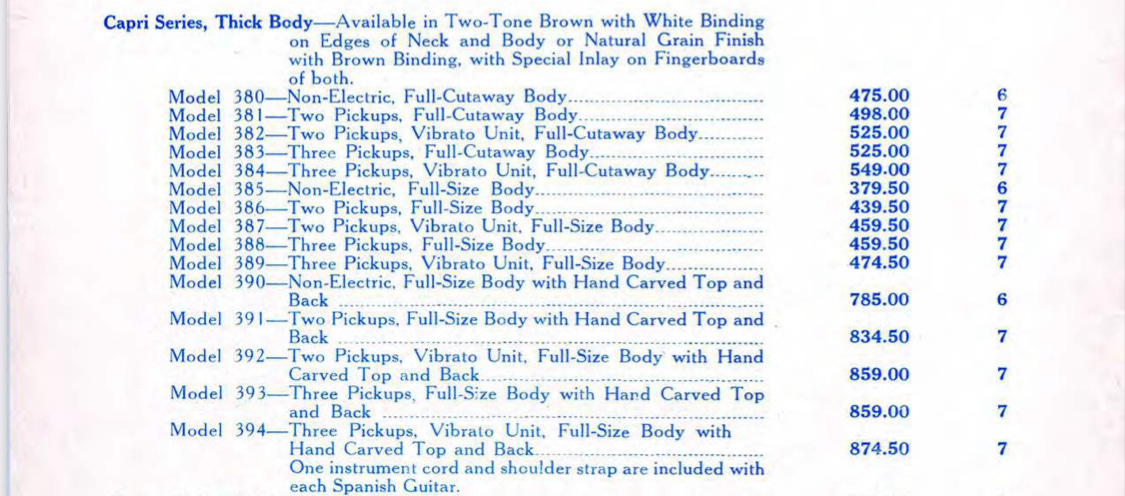
So deciphering this list today is difficult as many of these guitars were never even prototyped, and others have multiple models/prototypes associated with them that don’t necessarily match the description. So let’s take our best guess at what all of these guitars were supposed to be when they were added to the price list.
The big news for Rickenbacker in 1958 was the new Capri line of semi-hollowbodied guitars, which featured a 2” deep body. So obviously, the “Capri Series, Thick Body” models would be semi-hollow and have a…thicker body. Like this:
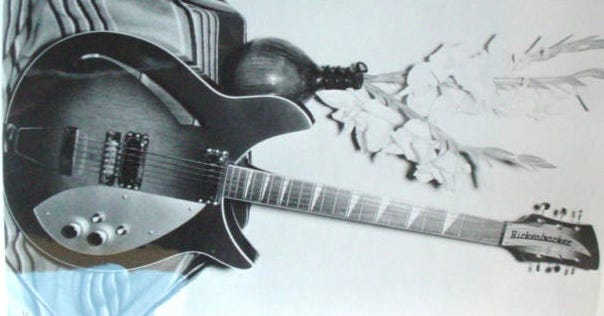
We know that the prototype above was referred to as a “381” and features a 3 3/16” body. With that in mind, and taking the model descriptions in the price list into consideration, we can make the following vaporware extrapolations:
Model 381: Two pickups, Full-Cutaway Body = a fat 360
Model 382: Two pickups, Vibrato Unit, Full-Cutaway Body = a fat 365
Model 383: Three pickups, Full-Cutaway Body = a fat 370
Model 384: Three pickups, Vibrato Unit, Full-Cutaway Body = a fat 375. A photo of a prototype 384 in this configuration exists, although it features a “traditional” f-hole instead of the normal Rickenbacker slash.
Now this is complicated slightly by the fact that at least one other version of the 381 exists from this time, and it features a German carve like the modern 381—as can be just barely made out from the reflections in the picture below:
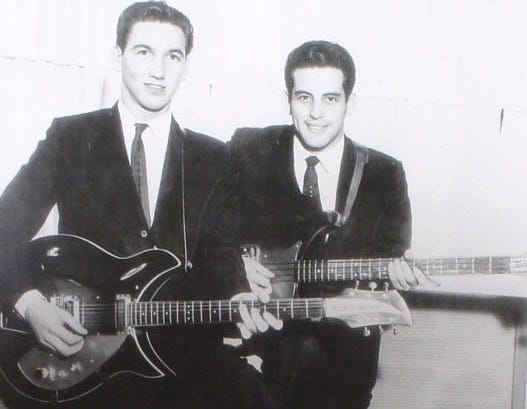
This guitar also feature a large Rose Morris style f-hole. Given that, plus the fact that the price list does not mention a carved top, and I’m going to stick with my original assumption that the flat-topped 381 is the “correct” one.
You’ll notice we skipped the 380. That’s because I simply have no idea what it could be. If we use the description alone, “Non-Electric, Full-Cutaway Body” and put it in the context of the 381-384 that have the same “Full-Cutaway” language, we could extrapolate that it’s an acoustic fat Capri. I mean, it couldn’t just be a Capri without pickups—a semi-hollow acoustic would…not sound great. But maybe a Capri shaped acoustic? Who knows. This vaporware will probably remain vapor…
Next up is the model 385. That model number will be used many times over the years to describe many different acoustic guitars. To make matters worse, here’s Ricky Nelson with two completely different 1958 385s:
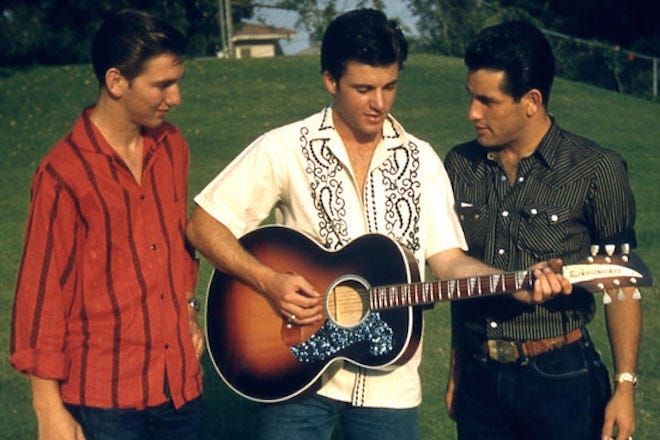
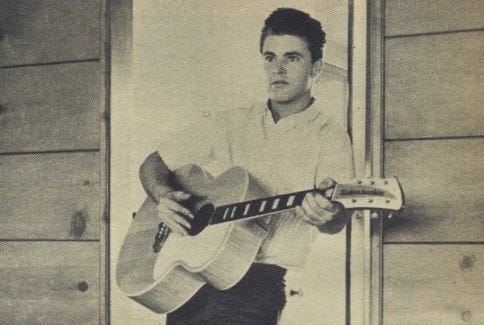
The latter is clearly inspired by the Gibson J200, and the former is almost a slightly scaled down version. So which is the vaporware price list 385? Or is it something else entirely? We’ll likely never know.
This makes narrowing down what the 386-389 might have been very difficult. There are no known prototypes of these models. All we have to go off of is “Full-Sized Body”. We know, based on the previous models it is possible that the 385 is of different construction than the 386-389–and it is indeed likely that they were. So let’s jump ahead a year to the 1959 price list and see if we can make an educated guess.

The F Series shows up on the 1959 price list and look at the language: “Thin Full Body”. It kinda makes sense, if you think about it, that if Rickenbacker was working on a big jazz box—which they were—they would develop a thick full body guitar first.
So—pure speculation here—I’m gonna say that:
Model 386: Two pickups, Full Size Body = a fat 360F
Model 387: Two pickups, Vibrato Unit, Full Size Body = a fat 365F
Model 388: Three pickups, Full Size Body = a fat 370F
Model 389: Three pickups, Vibrato Unit, Full Size Body = a fat 375F
Again, pure speculation. Wide open to corrections. Now in a couple years we’re going to get a little more information about one of these, but we’re not considering that here, and you’ll see why when we get there.
The 390, however, we know lots about—and we’re going to discuss it several times throughout this deep dive. Two 390 prototypes were handbuilt by Roger Rossmeisl—one in 1957, and one in 1958.
Here’s Roger with the 1957:
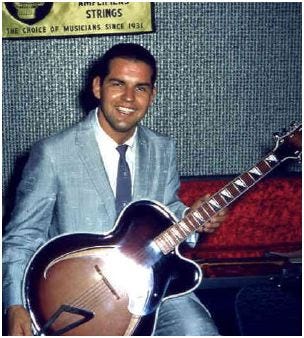
Here’s Sam Cooke with the 1958:
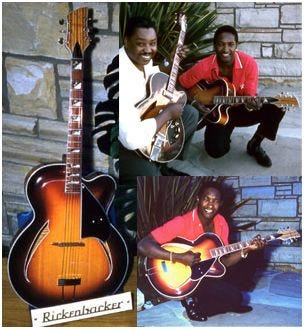
And here they both are together at a trade show, in the upper right hand corner of this picture. Also on the top row is the smaller 385 prototype—and in the bottom left corner is a certain 325 that would go on to become pretty famous.

The 390 featured a German carved spruce front and maple back, a multi-multi-multi ply neck, black and white triangle inlays, and Roger’s initials on the headstock. Reports from people who have played them are that they are beautiful, but as acoustic guitars…the hand carved tops are pretty thick and not terribly resonant. But as a foundation for an electric arch top jazz guitar? Just about perfect. And so while no 391-394 prototypes were ever built, it is fairly safe to assume that had they been they would be a 390 with the appropriate pickups.
All in all, it was a record year for vaporware!
1959
Vaporware: 16
Zombie guitars: 3
No new vaporware was added to the price list…but none of the 16 existing models were removed.
Three models, however, moved onto the zombie model list with no “production” examples produced apart from a couple of “leftover parts” guitars: The Combo 600, 800, and 850. They would go on to be zombies for a LONG time.
1961
Vaporware: 15
Zombie guitars: 7
The 650 was removed from the price list, reducing the vaporware total by 1. But just to confuse things further, here’s yet another prototype 385 of a completely different design:
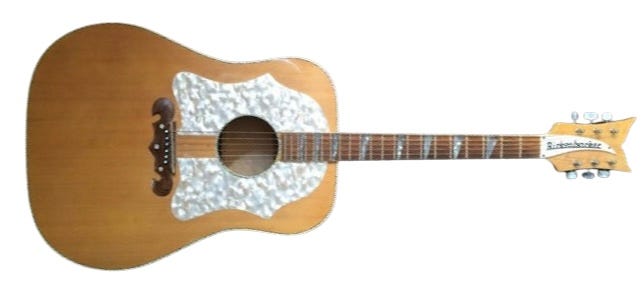
We will see this guitar with its double pickguard and “steer head” headstock again. Oh, and there’s another one like it built at the same time, but with a single pickguard. And another one with a smaller body called the 385S.

The 310, 315, 320, and 325 moved into the zombie category, where they likely would have remained until finally being dropped from the line were it not for that famous 325 we mentioned above. But we’ll come back to that later!
1964
Vaporware: 7
Zombie guitars: 3
The “Thick Body” series (the “Capri” moniker was dropped from all models on the 1960 price list) got a significant reduction, with the 382, 383, 384, 387, 388, 389, 393, and 394 all being dropped from the price list.
But remember how we speculated that the 386-389 might have been a thick F-bodied guitar? Well, the description of the 386 changed this year: “Two Pickups, Full-Size, Deep Body—Round Soundhole.” So what the heck does that look like? Which of the 385s we know about gets two pickups, or is it another guitar altogether? We’ll likely never know.
Thanks to that now-famous 325, the short scale 310, 315, 320, and 325 moved out of zombie status and back into production, dropping our total number of zombies down to 3.
1965
Vaporware: 7
Zombie guitars: 11
Technically the 8 full-body F Series guitars had been zombies for a while, with only a very few produced since 1961, but with the post British Invasion surge in demand for core products, the low volume F guitars never stood a chance, and moved to official zombie status.
1966
Vaporware: 7
Zombie guitars: 10
The 850 finally came off the price list, leaving only the 600, 800, and F series guitars as zombies.
1967
Vaporware: 9
Zombie guitars: 2
A completely redesigned F-Series launched with 4 models: the 360F, 365F, 370F, and 375F. It does not appear that the 365F or 375F were ever produced, making them the only guitars ever to have the distinction of moving from the zombie list to vaporware.
The non-deluxe F-Series models were removed from the price list, leaving the Combo 600 and 800 as the only zombie models.
1968
Vaporware: 8
Zombie guitars: 5
The 381 moved from vaporware to reality with the introduction of the German carved version of the 381 we know today.
Here’s a fun little picture from the 1968 catalog: the brand new 381 alongside 4 familiar prototypes that date back…a while! From left to right: 1961 385S, 1958 390, 1957 390, and 1961 385
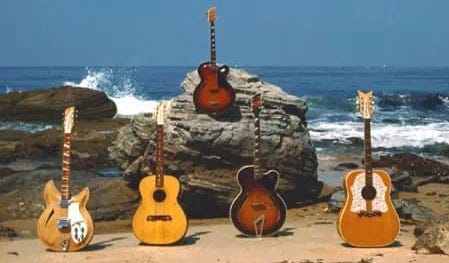
At long last the Combo 600 and 800 were dropped from the price list—ten years after last production. But they were quickly replaced by the short scale 900, 950, and 1000 which moved onto the zombie list after production wrapped in 1967. The last tremolo equipped 425 was also built in 1967, as was the 315, meaning they too moved onto the zombie list.
1969
Vaporware: 8
Zombie guitars: 15
10 guitars were added to the zombie list: the 2 F-Series guitars returned along with the Bantar and two Banjoline variants (6005 & 6006), the 625, the 4005/6 bass, and the 6/12 converter guitars—the 456/12, 336/12, and 366/12.
1971
Vaporware: 9
Zombie guitars: 20
I cannot find a record of the 1970 price list, so we have a lot of catching up to do! Especially because 1971 was a record year, with 29 of the 46 total models on the pricelist—over 60%!—being vaporware or zombies.
First the vaporware drops: the 386, 391 and 392 were removed from the price list 13 years after they first appeared.
But they were replaced by 4 new vaporware guitars: the 430, 470, and the 3000 and 3001 basses. Let’s talk about them.
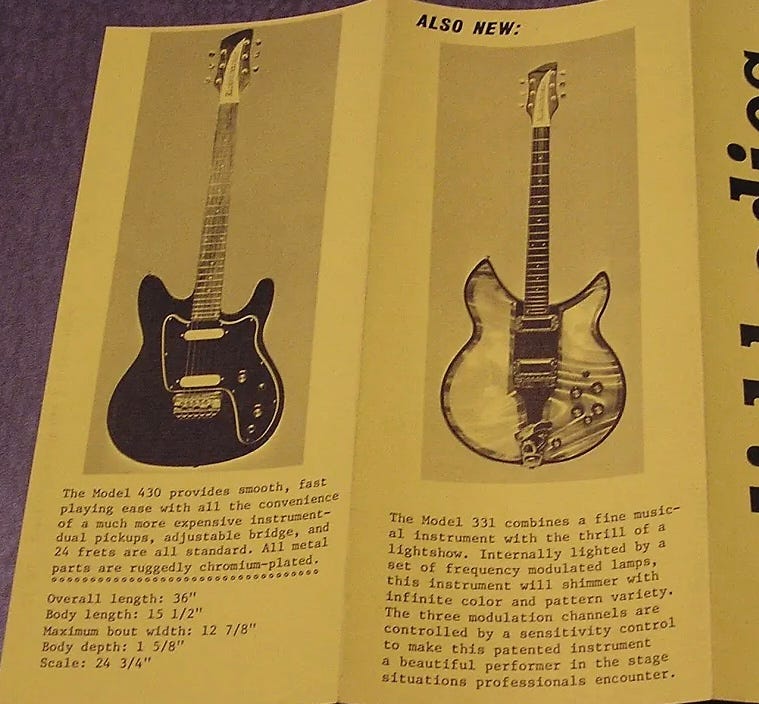
Rickenbacker guitars were decidedly not cool in the marketplace by 1971–and expensive to boot! This is the first of many appearances of the Forrest White-designed bastard child of a Telecaster and a Rickenbacker, and in this case it’s pretty much all Telecaster. Designed to be a “budget” guitar with its 24 fret bolt-on neck/solidbody construction and pickguard mounted electronics, it never actually went into production. The 430 that actually did go into production a couple years later used the same body shape…and that’s about it.
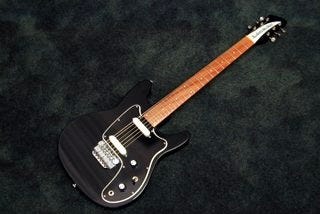
The 470 was a deluxe version of this guitar, with a bound neck, double bound body, and “deluxe keys” that I cannot find a good picture of anywhere—but they do appear to be pearloid like Van Ghents. And then there’s the basses.
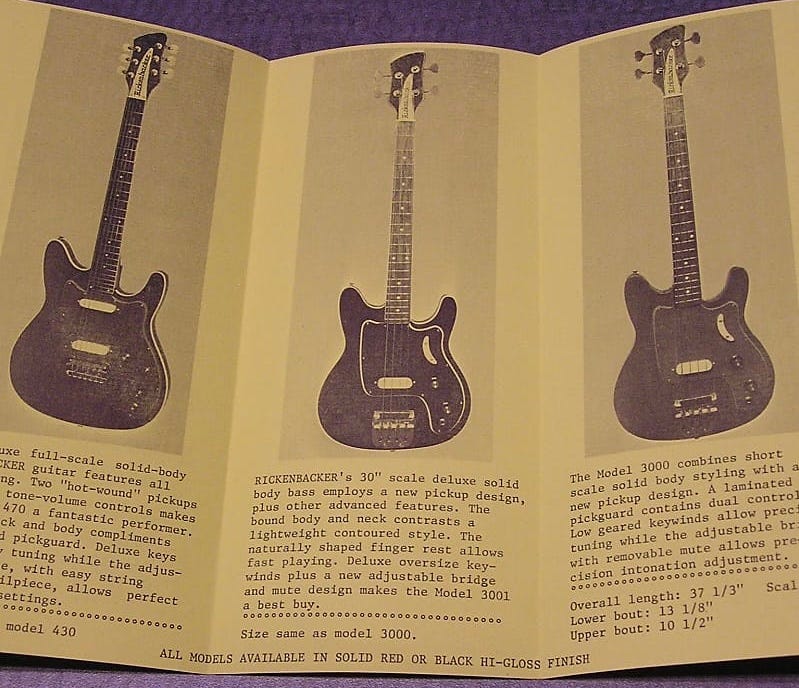
These too are not the 3000 and 3001 basses you are expecting. Both are short scale (30”) with a single pickup, and feature a new bridge design that would not be seen again. The 3000 is the standard version and the 3001 the “deluxe” with double bound body, bound neck, and “deluxe” tuners. The 3000 is similar in shape to the eventual production 3000 bass, but neither of these ever entered production.
It’s too hard to keep all the 1971 zombies in my head, so let’s just list them all:
315: Zombie since 1968
325: New zombie, last production 1969
335: New zombie, last production 1970
336/12: Zombie since 1969
345: New zombie, last production 1970
360F: Zombie since 1969
365: New zombie, last production 1969
366/12: Zombie since 1969
370F: Zombie since 1969
375: New zombie, last production 1969
425: Zombie since 1968
456/12: Zombie since 1969
615: New zombie, last production 1969
625: Zombie since 1969
900: Zombie since 1968
950: Zombie since 1968
4005/6: Zombie since 1969
6000 Bantar: Zombie since 1969
6005 Banjoline: Zombie since 1969
6006 Banjoline: Zombie since 1969
On the plus side, the 1000 was dropped from the price list and therefore the zombie list.
1973
Vaporware: 1
Zombie guitars: 17
All preexisting vaporware guitars dropped off the price list. But a new one was added: the 490.
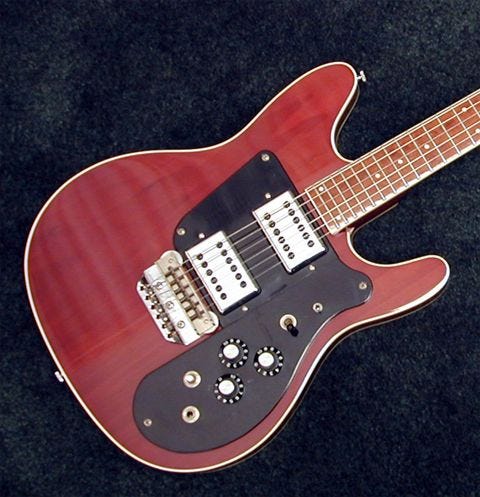
The 430/470 body shape returned in deluxe form with a new bridge and an unusual party trick: the pickguard and electronics were designed to be removable/changeable, with (at least) Telecaster style, Rickenbacker, double humbucker, and active pickup modules. The guitar above appears to be the only prototype.
The 331 Lightshow moved to the zombie list. In an odd twist, while a 12 string 360F had been produced it had never been on the price list. In 1973, for some reason, it was added to the price list…as a zombie, as none had been produced since 1969.
The 345, 375, 360F, 370F, and 425 were dropped from the price list and therefore the zombie list.
1975
Vaporware: 1
Zombie guitars: 15
In 1975, the 490 dropped off the price list but was replaced by a new piece of vaporware: the 4001/8.
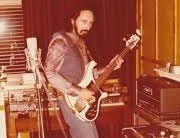
Two White with black trim 8 string 4001s featuring the odd “potato head” headstock first seen on the 4005/8 had been produced in 1973, ending up in the hands of John Entwistle and Chris Squire. Just like on 12-string guitars, the octave strings were strung “backwards”. While Squires’ was often seen on stage, the model never made it into production.
No 4005s were produced between 1974-1979, earning the 4005 a spot on the list. However, the 315, 615, and 625 were dropped from the price list, bringing the zombie guitar total down to 15.
1976
Vaporware: 0
Zombie guitars: 10
The 4001/8 was removed from the price list, taking the vaporware total down to 0 for the first time since 1956.
The 325, 456/12, Bantar, and Banjoline twins disappeared from the price list, and therefore the zombie list.
1977
Vaporware: 0
Zombie guitars: 7
With production having ended in early 1976, the 430 joined the zombie list. The 365, 331 Lightshow, and the 6/12 converters 336/12 and 366/12 rolled off the price list.
1978
Vaporware: 0
Zombie guitars: 6
The last “with vibrato” guitar, the 335, disappeared off the price list 8 years after the last guitar left the factory with a vibrato.
1979
Vaporware: 0
Zombie guitars: 4
The 4005/6 is finally dropped from the price list, and the first production run since 1974 moved 4005 from the zombie list back to active.
1980
Vaporware: 0
Zombie guitars: 4
2 come off the zombie list, 2 go on. 13 years after their last production runs, the 900 and 950 finally came off the price list only to be replaced on the zombie list by the 3000 and 3001 basses, whose production wrapped in 1979.
1981
Vaporware: 0
Zombie guitars: 3
The 360F/12 is dropped from the price list, leaving the 430, 3000, and 3001 as the only zombie guitars.
1982
Vaporware: 7
Zombie guitars: 4
The second vaporware 8-string bass was added to the price list—the 4008. While a handful of prototypes were built and sold, there would be no subsequent production. A 4001 with an extended headstock and modified bridge, the idea would be revisited in 1986–using the 4003’s beefier neck—as the 4003S/8

In a mid year price list addition, 2 new models are introduced that are never mentioned anywhere else again: the 355 Liverpool Plus (a 350 with an Accent Vibrato) and the 655 Brighton, described as a “special metallic Ruby finish with all black trim and matte black hardware, 2 pickups, with vibrato.” Neither ever made it to production. As to what body style the 655 was based on…we have no information or known prototypes.
I’m kinda torn on the next few items. The 200/2000 series guitars and basses—the fourth appearance of the Forrest White “Tele”-style body—appeared on that same price list addition. While they did appear in late 1984, they did not appear on the 1983 price list. We’re going to call this premature launch vaporware.
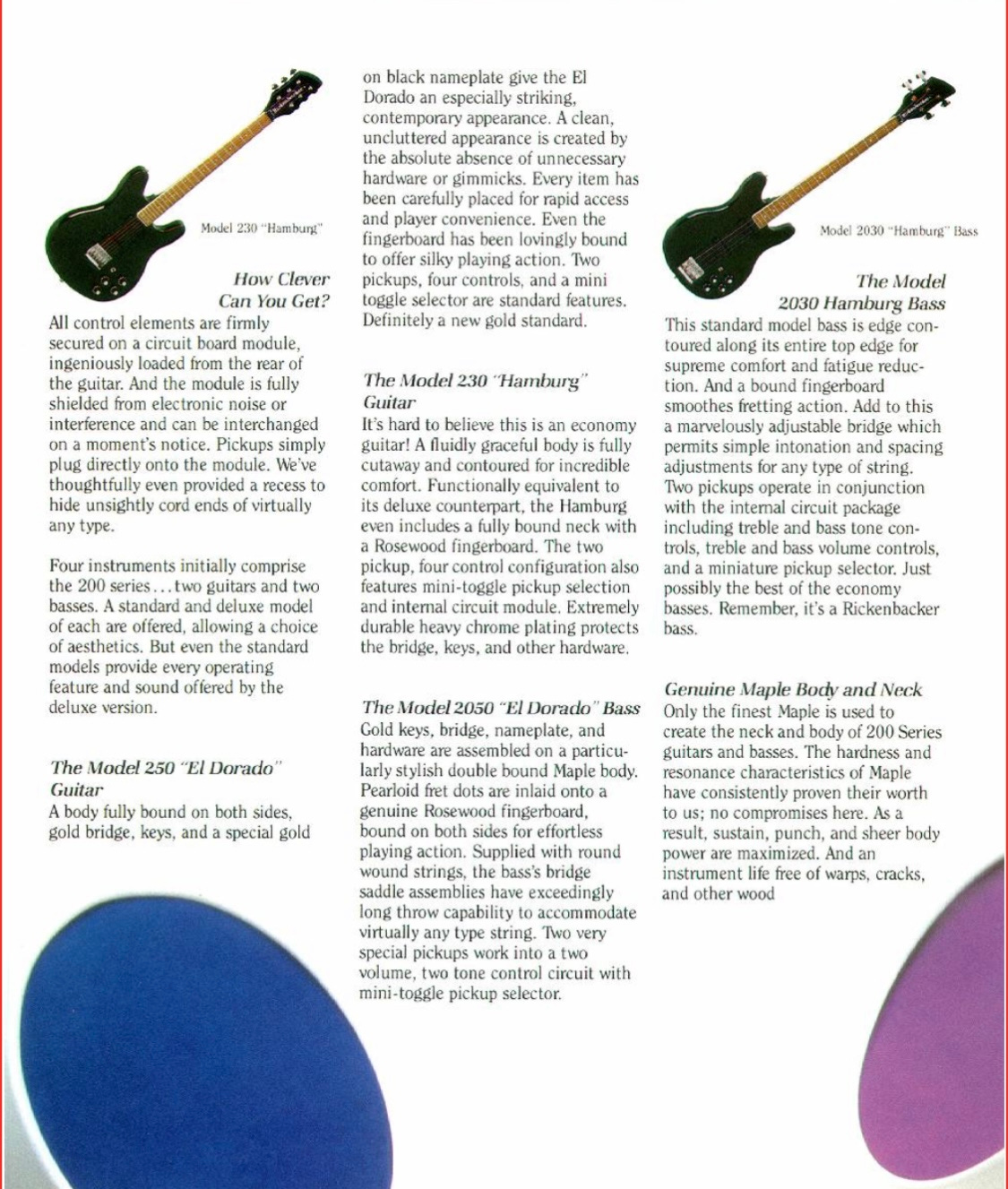
In another head-scratcher, the 483 was added to the price list for the first time. Apart from a 1974 batch, no 483s had ever been built. No more would be, meaning the 483 would be added to the list as a zombie. The 430 would be dropped from the price list to offset. And after first appearing on the price list in 1959 (as the 425), the 420 moved to the zombie list.
1983
Vaporware: 1
Zombie guitars: 8
The 355 Liverpool Plus, 655 Brightonand 200/2000 series guitars fail to appear on the pricelist, leaving the 4008 as the sole Vaporware offering.
The 4005 moved back to the zombie list after its last production run in 1982. And with production on the 480 and 482 ending in 1982, they joined their 3-pickup cousin 483 as zombie guitars. The final addition to the zombie list was the 460 after a 21 year run.
1985
Vaporware: 1
Zombie guitars: 0
The price list went through a significant restructuring in 1985 after John Hall’s acquisition of the company. All existing zombie guitars were purged. A new “custom order” category was created, with many items that could theoretically be classified as “vaporware”—ever see a 370WB VB from this era? I haven’t either, but it’s on the price list.
I’m going to be kind and say that given how this was a one year only experiment, we’re not going to count these questionable guitars as vaporware. Any one of them COULD be made with off the shelf parts, so let’s assume the best.
That said, the 4008 remained on the price list and was still vaporware, although early 4003S/8s did begin appearing at the end of the year.
1986
Vaporware: 0
Zombie guitars: 0
A new, clean pricelist meant no vaporware or zombie guitars.
1988
Vaporware: 0
Zombie guitars: 2
The last production 4080 or 4080/12 was built in 1987, moving the doubleneck twins to the zombie list.
1993
Vaporware: 0
Zombie guitars: 0
The 4080 and 4080/12 were removed from the price list, dropping our zombie guitars back down to 0.
1995
Vaporware: 1
Zombie guitars: 4
Talk about getting your money’s worth! Take a look at the 760J Jazz-bo from the 1995 catalog:

Look familiar? What if we removed the photoshopped-on neck?
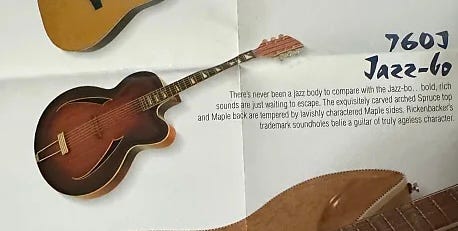
Is that the 1958 Roger Rossmeisl-built 390 being introduced as a new guitar? Sure is!
Now to be fair, they did build a new prototype for the NAMM show.
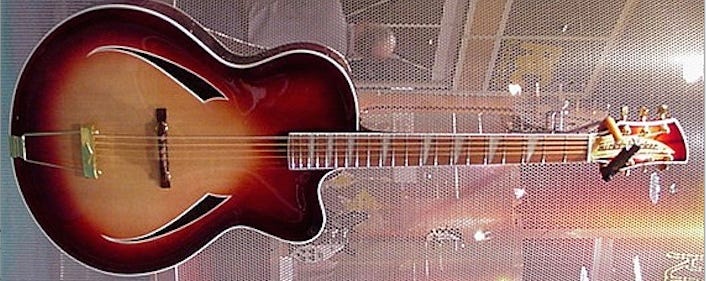
And then no more. Still vaporware. Almost forty years on…
The 200/2000 series of guitars and basses wrapped production in 1994, although the 1995 pricelist hadn’t quite caught up. The 220, 260, 2020, and 2060 moved to the zombie list.
1998
Vaporware: 1
Zombie guitars: 0
The 200/2000 guitars and basses are off the price list, dropping zombie guitars down to 0.
2007
Vaporware: 0
Zombie guitars: 0
The 760J Jazz-bo—and the entire acoustic line—was removed from the price list, taking our vaporware back down to 0.
2016
Vaporware: 0
Zombie guitars: 1
The 650C Colorado wrapped production in 2015, meaning its inclusion on the 2016 price list earns it a spot on the zombie list.
2018
Vaporware: 0
Zombie guitars: 0
The 650C Colorado is removed from the price list.
And that’s how it’s been ever since! Here’s a model by model rundown:
220: (Z) 1995-1997
230 Hamburg: (V) 1982
250 El Dorado: (V) 1982
260: (Z) 1995-1997
310: (Z) 1961-1963
315: (Z) 1961-1963, 1968-
320: (Z) 1961-1963
325: (Z) 1961-1963, 1971-1975
330F: (Z) 1965-1966
331: (Z) 1973-1976
335: (Z) 1971-1977
335F: (Z) 1965-1966
336/12: (Z) 1969-1976
340F: (Z) 1965-1966
345: (Z) 1971-1972
345F: (Z) 1965-1966
355 Liverpool Plus: (V) 1982
360F: (Z) 1965-1966, 1969-1972
360F/12: (Z) 1973-1980
365: (Z) 1971-1976
365F: (Z) 1965-1966, (V) 1967-1972
366/12: (Z) 1969-1976
370F: (Z) 1965-1966, 1969-1972
375: (Z) 1971-1972
375F: (Z) 1965-1966, (V) 1967-1985
380: (V) 1958-1972
381: (V) 1958-1967
382: (V) 1958-1963
383: (V) 1958-1963
384: (V) 1958-1963
385: (V) 1958-1972
386: (V) 1958-1970
387: (V) 1958-1963
388: (V) 1958-1963
389: (V) 1958-1963
390: (V) 1958-1972
391: (V) 1958-1970
392: (V) 1958-1970
393: (V) 1958-1963
394: (V) 1958-1963
420: (Z) 1982-1984
425: (Z) 1968-1972
430: (V) 1971-1972, (Z) 1977-1981
456/12: (Z) 1969-1975
460: (Z) 1983-1984
470: (V) 1971-1972
480: (Z) 1982-1984
481: (Z) 1982-1984
483: (Z) 1982-1984
490: (V) 1973-1974
600: (Z) 1959-1967
615: (Z) 1971-1974
625: (Z) 1969-1974
650: (V) 1957-1960
655 Brighton: (V) 1982
650C: (V) 2016-2017
760J: (V) 1995-2006
800: (Z) 1959-1967
850: (Z) 1959-1965
900: (Z) 1968-1979
950: (Z) 1968-1979
1000: (Z) 1968-1970
2020: (Z) 1995-1997
2030 Hamburg: (V) 1982
2050 El Dorado: (V) 1982
2060 (Z): 1995-1997
3000: (V) 1971-1972, (Z) 1980-1984
3001: (V) 1971-1972, (Z) 1980-1984
4001/8: (V) 1975
4005: (Z) 1975-1978, 1982-1984
4005/6: (Z) 1969-1979
4008 (V) 1982-1985
4080: (Z) 1988-1992
4080/12: (Z) 1988-1992
6000 Bantar: (Z) 1969-1975
6005 Banjoline: (Z) 1969-1975
6006 Banjoline: (Z) 1969-1975




That was a fun read!
OCD is a blessing and a curse!